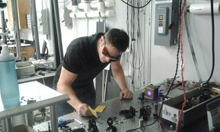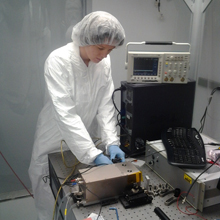



The thin-disk laser architecture is an alternative route to address solid-state laser thermal issues. The first thin-disk laser was demonstrated by Giesen et al. in 1994, and as such thin-disk lasers represent the current state-of-the-art in solid-state laser systems for high energy and high average power. The design of the thin-disk system minimizes the thermal lensing and thermally induced birefringence problems that plague more traditional rod and slab shaped laser gain media.
The thin-disk architecture distributes its heat over a thin (100 to 200 Ám) medium with a relatively large cross-sectional diameter (5 to 20 mm), so that the heat flux is oriented collinearly with the direction of beam propagation. And because the beam diameter of a thin-disk system is typically on the order of 1-2 cm or larger, even high power operation of thin-disk systems does not approach the damage threshold of the disk and other cavity elements. Both the large beam diameter and the short length of the gain medium make a thin-disk laser relatively impervious to the non-linear effects that specifically limit fiber lasers systems. This makes a thin-disk system ideal for high peak and average power operation.
The Laser Plasma Laboratory (LPL) has partnered with TRUMPF GmbH and TRUMPF USA, the leading manufacturer of thin disk laser systems, in a collaborative research project. A TRUMPF TruMicro 7050 system is being evaluated for high power EUV applications. Plans are currently underway for the modify another TRUMPF system for use with our established droplet technology for the generation of high average power, high brightness, incoherent UV and EUV light sources. This work will have applications in EUV generation, materials processing, ceramic laser and wavefront distortions in solid state laser media.